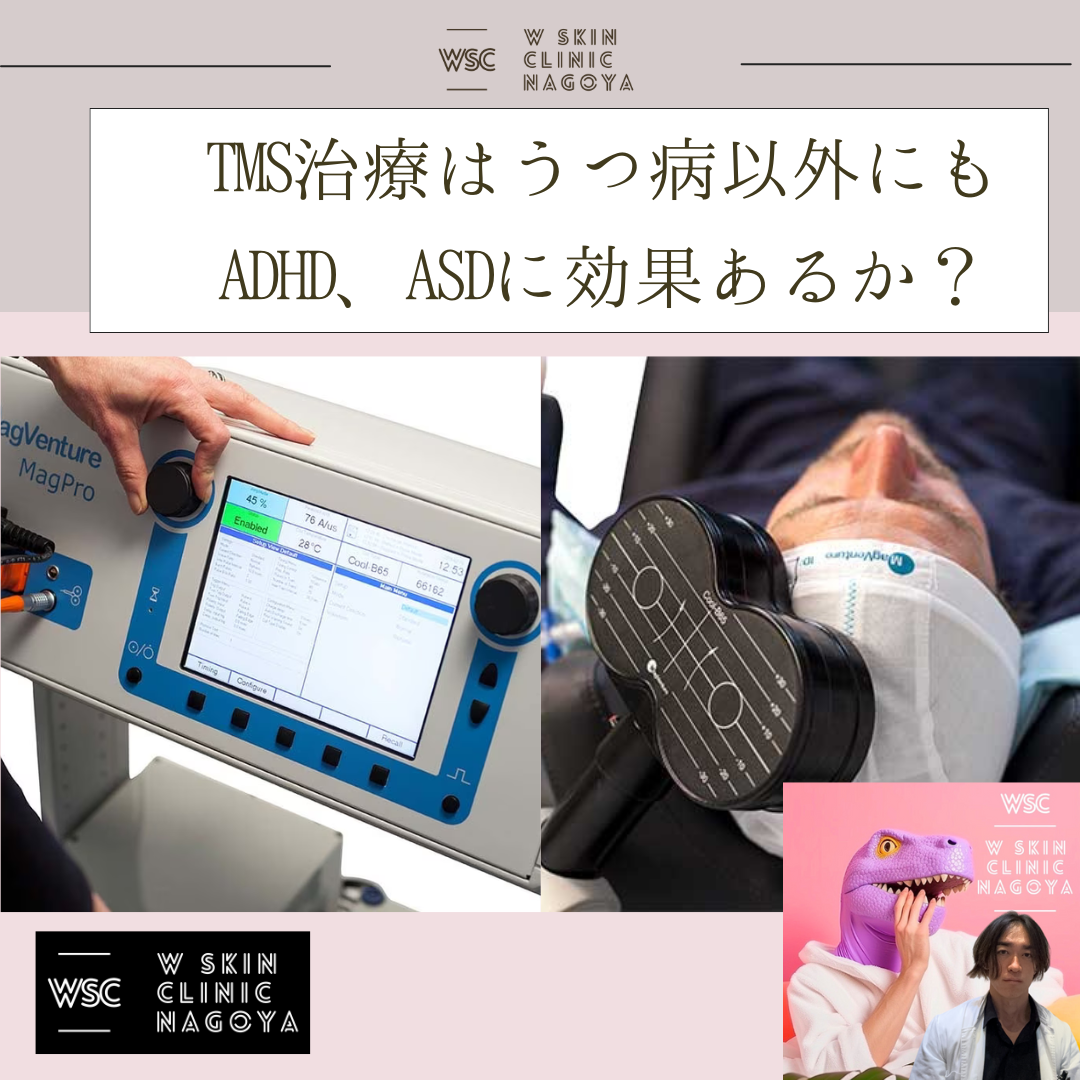NEWSお知らせ
2024.11.07|ブログ
TMS治療はうつ病だけでなく、ADHD、ASDにも有効性を発揮する可能性あるか?名古屋の美容皮膚科医が解説

TMS治療はうつ病だけでなく、ADHD、ASDにも有効性を発揮する可能性あるか?名古屋の美容皮膚科医が解説
こんにちは、Wスキンクリニック名古屋、院長の加藤晃司です。
今回は、TMS治療はうつ病だけでなく、ADHD、ASDにも有効性を発揮する可能性あるか?について解説します。
TMS(経頭蓋磁気刺激)治療は、うつ病だけでなく、ADHDやASDに対しても有効性を発揮する可能性があるとされています。それぞれの疾患に対して異なる脳領域が関与するため、適切な部位に刺激を与えることで、症状の改善が期待されています。以下に、それぞれの疾患におけるTMS治療の効果とそのメカニズムについて詳しく説明します。
- TMS治療の仕組み
TMS治療は、頭皮の上から脳に電磁波を送って、神経活動を刺激または抑制する治療法です。うつ病治療では、前頭前野(特に左背外側前頭前野)を刺激し、気分や情動の調節を改善することが確認されています。TMSは非侵襲的で安全性が高く、副作用も少ないため、他の精神疾患や発達障害にも応用され始めています。
- TMS治療のADHDに対する効果
ADHD(注意欠如・多動症)における症状は、前頭前野や側頭皮質の機能低下と関連が深いとされています。TMSは、これらの脳領域に刺激を与えることで、ADHDの症状に影響を与える可能性があります。
- メカニズム
前頭前野の活性化:ADHDの症状は、注意力や衝動抑制に関連する前頭前野の機能低下と関わっているとされます。TMSで前頭前野を刺激することで、脳の神経活動が活性化され、注意力や行動の制御が改善されやすくなります。
ドーパミンの分泌促進:ADHDではドーパミンの分泌量が低下していることが多く、TMSによる刺激でドーパミン分泌が増加することで、注意力や衝動性が改善されると考えられています。
- 有効性に関する研究
一部の研究では、ADHD患者に対するTMS治療が注意力の改善や多動性の抑制に効果を示すと報告されています。
ただし、効果は個人差があり、継続的な治療が必要な場合もあります。現時点では、ADHD治療におけるTMSの効果をより確立するための研究が進められています。
- TMS治療のASDに対する効果
ASD(自閉スペクトラム症)は、社会的コミュニケーションの困難や行動の偏りが特徴で、脳のネットワーク異常が原因の一つとされています。TMSは、ASDに関連する脳領域に刺激を与え、神経ネットワークを再構築することで、症状の緩和が期待されています。
- メカニズム
神経ネットワークの調整:ASDでは、脳内の異なる領域間のネットワーク調整がうまく機能していないことが多いとされます。TMSで脳に刺激を与えることで、これらの領域の活動を調整し、情報処理の効率を高めることが期待されます。
社会的認知の改善:社会的認知に関わる側頭皮質や前頭前野をTMSで刺激することにより、社会的な理解力や対人関係のスキルが向上する可能性があるとされています。
- 有効性に関する研究
ASDに対するTMS治療の研究は進行中で、社会的な相互作用や言語理解、行動の柔軟性が改善した例が報告されています。ただし、効果には個人差が大きく、治療部位や刺激パターンを個別に調整する必要があります。
TMS治療がASDの不安や強迫行動を軽減したり、行動の柔軟性を改善したりする効果も確認されていますが、さらなる大規模研究が求められています。
- TMS治療のうつ病に対する効果との比較
TMS治療は、うつ病治療において比較的確立された治療法で、特に抗うつ薬に反応しない治療抵抗性うつ病に効果を示すとされています。うつ病患者の多くで、前頭前野の活動低下が確認されているため、TMSによる刺激で前頭前野の神経活動を活性化し、症状が改善されます。
うつ病との違い:うつ病の場合は感情や気分のコントロールに作用する脳部位が主なターゲットですが、ADHDやASDの場合は注意力、行動の制御、社会的認知など、より広範囲での脳機能改善を目指して、複数の領域をターゲットにする必要があります。
施術の設定:うつ病では標準的な刺激パターンが確立されていますが、ADHDやASDは個別の症状に応じて調整が必要なため、最適な治療設定を決定するまでに試行錯誤が必要です。
- TMS治療における注意点と課題
TMSは安全性が高いとされていますが、ADHDやASDへの適用においては、注意すべき点があります。
- 個別の調整が必要
ADHDやASDは症状の現れ方が非常に多様で、個別の症状に応じた治療部位や刺激パターンの調整が求められます。例えば、ADHDでは注意力に関わる領域、ASDでは社会的認知に関わる領域への刺激が考慮されます。
- 持続効果の確認
ADHDやASDにおけるTMS治療の効果がどれくらい持続するか、またどの程度の頻度で施術を継続する必要があるかについては、明確な結論が出ていないため、継続的な評価が求められます。
- 副作用について
TMSは非侵襲的で重篤な副作用は少ないとされていますが、ADHDやASDの方では過敏性が高いことがあり、頭痛や疲労感、軽度の不安感が出ることもあります。
まとめ
TMS治療は、うつ病だけでなく、ADHDやASDに対しても一定の効果が期待されています。ADHDでは前頭前野の活性化やドーパミン分泌の促進が、ASDでは神経ネットワークの調整や社会的認知の向上が主な目的となります。治療設定やターゲット領域の調整が必要であり、個別の症状に応じたアプローチが大切です。また、継続的な研究が進むことで、ADHDやASDに対するTMS治療の有効性がさらに確立されていくことが期待されています。
Wスキンクリニック名古屋でのエクソソーム治療はこちら
https://www.w-clinic-nagoya.com/acne/exosome
NMN点滴はこちら
https://www.w-clinic-nagoya.com/beauty-drip/nmn
高濃度ビタミンC点滴はこちら
https://www.w-clinic-nagoya.com/beauty-drip/vitamin-c
*当院では
NMNは一般社団法人NMN医療研究会、エクソソームはセルソース株式会社のM2P-エクソソームを使用しています。
TMS治療はこちら
https://www.w-clinic-nagoya.com/tms
当院では無料でスタッフカウンセリングを行なっております。
お気軽にご予約くださいませ
Wスキンクリニック名古屋 (美容皮膚科)
https://www.w-clinic-nagoya.com/
〒461-0005 愛知県名古屋市東区東桜 2-4-1 第3コジマビル6F
TEL 052-7377-7117(10:00~19:00)
LINE ID @w.nagoya
高岳駅より徒歩4分 / 新栄町駅より徒歩5分
お車でお越しの方
名鉄協商パーキングチケットをお渡しいたしますので、クリニック近くのパーキングをご利用ください。
ご予約、お問合せ、Wスキンクリニック名古屋公式LINEからも可能です。
LINE ID : @w.nagoya
友達追加は↓から
Wスキンクリニック名古屋公式インスタ↓
https://www.instagram.com/w.skinclinic.nagoya?igsh=NHhoODFnaXB2b2ll&utm_source=qr
Wスキンクリニック院長 加藤晃司インスタ↓
https://www.instagram.com/w.skin.nagoya.kojikato?igsh=aW9nbWZwNjNjZ3pz&utm_source=qr
Can TMS Therapy Be Effective Not Only for Depression but Also for ADHD and ASD? Explained by Dr. Koji Kato, Dermatologist at W Skin Clinic Nagoya
Hello, I’m Dr. Koji Kato from W Skin Clinic Nagoya.
Today, I’ll be discussing whether TMS (Transcranial Magnetic Stimulation) therapy, primarily used for depression, may also show effectiveness for ADHD (Attention Deficit Hyperactivity Disorder) and ASD (Autism Spectrum Disorder).
TMS is a non-invasive therapy in which electromagnetic pulses are delivered through the scalp to stimulate or modulate neuronal activity in targeted brain areas. While TMS is well-documented for depression, recent studies have indicated that it may also have therapeutic potential for ADHD and ASD by stimulating specific brain regions to improve symptoms. Below is a breakdown of TMS’s mechanisms, potential benefits, and its current state of research for these conditions.
- How TMS Therapy Works
TMS therapy uses electromagnetic pulses to stimulate specific areas of the brain. In depression, it typically targets the dorsolateral prefrontal cortex, which regulates mood and emotional processing. TMS is considered a safe and non-invasive treatment, with minimal side effects, making it a promising option for other psychiatric and developmental disorders.
- Effectiveness of TMS Therapy for ADHD
ADHD symptoms are often associated with decreased function in the prefrontal cortex and temporal regions. Targeting these areas with TMS may help alleviate ADHD symptoms.
- Mechanisms for ADHD:
Activation of the Prefrontal Cortex: ADHD is linked to reduced activity in the prefrontal cortex, which plays a role in attention and impulse control. Stimulating this area with TMS could improve attention and behavior regulation.
Dopamine Release: Many individuals with ADHD show reduced dopamine levels. TMS stimulation may increase dopamine production, which can aid in improving attention and reducing impulsivity.
- Efficacy in Studies:
Some studies have shown improvements in attention and reductions in hyperactivity following TMS treatment in individuals with ADHD.
However, response varies, and some patients may require ongoing treatment to maintain benefits. Further research is underway to confirm and refine these findings.
- Effectiveness of TMS Therapy for ASD
ASD, which is characterized by difficulties in social interaction, communication, and repetitive behaviors, is thought to be partly due to abnormalities in brain connectivity. TMS may aid in modulating neural networks related to social and cognitive functions, providing symptom relief.
- Mechanisms for ASD:
Neural Network Regulation: In ASD, disruptions in connectivity between brain regions are common. TMS may help regulate this network activity, enhancing processing efficiency and communication between brain areas.
Improvement in Social Cognition: Targeting the temporal and prefrontal regions involved in social cognition with TMS has shown potential for improving social understanding and interpersonal skills.
- Efficacy in Studies:
Initial studies on TMS for ASD have reported improvements in social interaction, language comprehension, and behavioral flexibility.
Effects can be individualized, and the optimal settings for stimulation may vary by patient, underscoring the need for personalized treatment approaches. More large-scale studies are still required to substantiate these early findings.
- Comparison with TMS Effectiveness in Depression
For depression, TMS therapy is a well-established treatment, especially in cases resistant to antidepressants. In depressed patients, underactivity in brain areas regulating mood is commonly observed, and TMS helps restore balance by stimulating these regions.
Differences:
In depression, TMS primarily targets regions controlling mood, while in ADHD and ASD, it requires more nuanced targeting across broader cognitive and behavioral networks.
Protocols in depression are standardized, whereas ADHD and ASD may require adjustments in stimulation patterns based on individual symptoms and brain activity profiles.
- Considerations and Challenges in TMS Therapy for ADHD and ASD
While TMS is generally safe, special considerations apply when used for ADHD and ASD.
- Need for Personalized Treatment:
ADHD and ASD symptoms are highly diverse, so TMS protocols need to be tailored to individual symptoms and specific brain regions, such as the prefrontal cortex for ADHD and social cognition areas for ASD.
- Duration of Effect:
While some patients experience lasting benefits, it’s still unclear how long the effects last in ADHD and ASD, and some may need maintenance sessions for sustained improvements.
- Potential Side Effects:
Although TMS has a low risk of serious side effects, individuals with ADHD or ASD may have heightened sensitivity, and some may experience headaches, fatigue, or mild anxiety.
Summary
TMS therapy shows promise not only for depression but also for ADHD and ASD. In ADHD, the goal is to activate the prefrontal cortex and increase dopamine, while in ASD, TMS may help in adjusting neural connectivity and improving social cognition. While positive results have been reported, individualized approaches and further research are needed to optimize its use for ADHD and ASD.
As studies progress, TMS may emerge as a more widely accessible treatment option for these conditions, providing another non-invasive approach for those seeking symptom relief.




